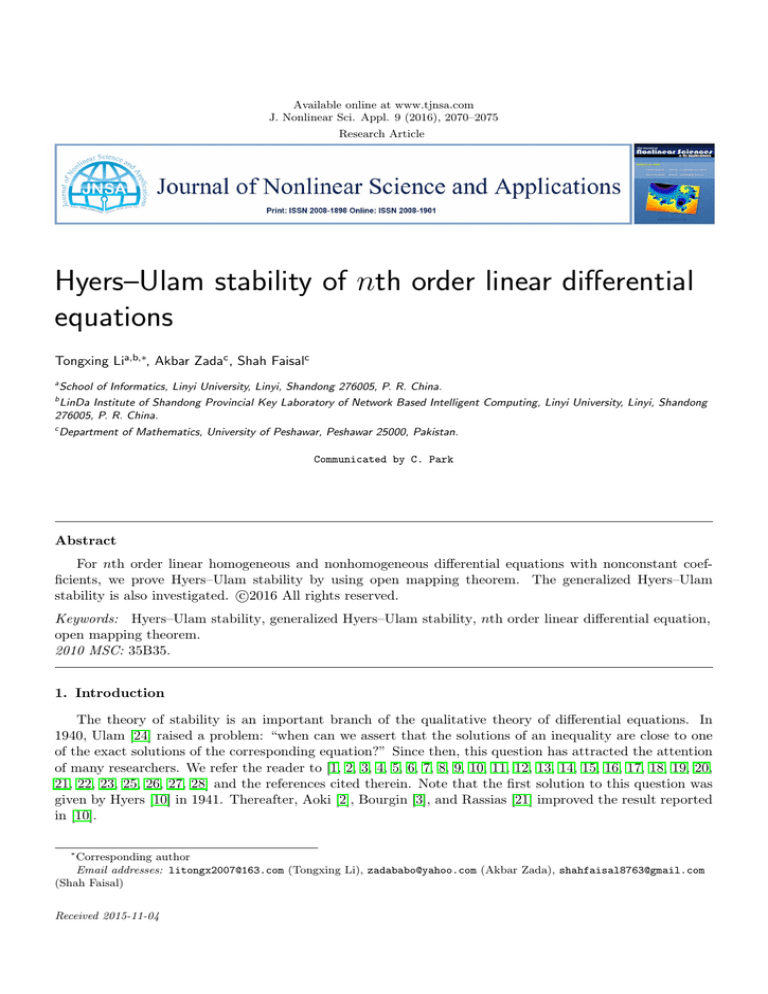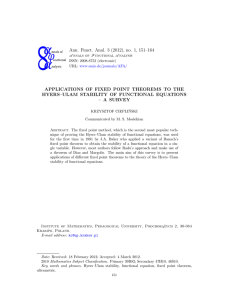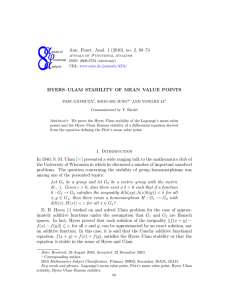
Available online at www.tjnsa.com
J. Nonlinear Sci. Appl. 9 (2016), 2070–2075
Research Article
Hyers–Ulam stability of nth order linear differential
equations
Tongxing Lia,b,∗, Akbar Zadac , Shah Faisalc
a
School of Informatics, Linyi University, Linyi, Shandong 276005, P. R. China.
b
LinDa Institute of Shandong Provincial Key Laboratory of Network Based Intelligent Computing, Linyi University, Linyi, Shandong
276005, P. R. China.
c
Department of Mathematics, University of Peshawar, Peshawar 25000, Pakistan.
Communicated by C. Park
Abstract
For nth order linear homogeneous and nonhomogeneous differential equations with nonconstant coefficients, we prove Hyers–Ulam stability by using open mapping theorem. The generalized Hyers–Ulam
c
stability is also investigated. 2016
All rights reserved.
Keywords: Hyers–Ulam stability, generalized Hyers–Ulam stability, nth order linear differential equation,
open mapping theorem.
2010 MSC: 35B35.
1. Introduction
The theory of stability is an important branch of the qualitative theory of differential equations. In
1940, Ulam [24] raised a problem: “when can we assert that the solutions of an inequality are close to one
of the exact solutions of the corresponding equation?” Since then, this question has attracted the attention
of many researchers. We refer the reader to [1, 2, 3, 4, 5, 6, 7, 8, 9, 10, 11, 12, 13, 14, 15, 16, 17, 18, 19, 20,
21, 22, 23, 25, 26, 27, 28] and the references cited therein. Note that the first solution to this question was
given by Hyers [10] in 1941. Thereafter, Aoki [2], Bourgin [3], and Rassias [21] improved the result reported
in [10].
∗
Corresponding author
Email addresses: litongx2007@163.com (Tongxing Li), zadababo@yahoo.com (Akbar Zada), shahfaisal8763@gmail.com
(Shah Faisal)
Received 2015-11-04
T. Li, A. Zada, S. Faisal, J. Nonlinear Sci. Appl. 9 (2016), 2070–2075
2071
To the best of our knowledge, papers by Obloza [17, 18] were among the first contributions dealing
with Hyers–Ulam stability of differential equations. Alsina and Ger [1] proved Hyers–Ulam stability of
differential equation y 0 (x) = y(x). Later, Takahasi et al. [23] extended results of [1] to the Banach spacevalued differential equation y 0 (x) = λy(x) (Hyers–Ulam stability holds true for this equation). Using direct
method, iteration method, fixed point method, and open mapping theorem, Huang and Li [9] investigated the
Hyers–Ulam stability of some classes of functional differential equations. In the paper by Zada et al. [26], the
concepts of Hyers–Ulam stability are generalized for a class of nonautonomous linear differential systems.
Very recently, Choi and Jung [6] studied the generalized Hyers–Ulam stability of the linear differential
equation
y 00 (x) + f (x)y 0 (x) + g(x)y(x) = r(x).
It should be noted that research in this paper was strongly motivated by the recent contributions of Choi
and Jung [6] and Huang and Li [9]. Our principal goal is to prove Hyers–Ulam stability of
n
X
βn−i (x)y (n−i) (x) = α(x)
(1.1)
i=0
and the generalized Hyers–Ulam stability of
y (n) (x) +
n
X
Qn−i (x)y (n−i) (x) = f (x)
(1.2)
i=1
by using different approaches.
2. Preliminaries
We present the following definitions to make this paper self-dependent.
Definition 2.1 ([12, 13]). Let W be a normed space and I be an open interval. Then, equation (1.1) is
said to have Hyers–Ulam stability on I if, for any function g : I → W satisfying
n
X
(n−i)
β
(x)g
(x)
−
α(x)
≤ε
n−i
i=0
for all x ∈ I and for some ε ≥ 0, there exists a function g0 : I → W such that
n
X
(n−i)
βn−i (x)g0
(x) = α(x)
i=0
and kg − g0 k ≤ K(ε) for all x ∈ I, where K(ε) is an expression for ε only.
If the above statement is also true when we replace ε and K(ε) with φ(x) and Φ(x), where φ, Φ : I →
[0, ∞) are functions not depending on g and g0 explicitly, then we say that the corresponding differential
equation has the generalized Hyers–Ulam stability (or the Hyers–Ulam–Rassias stability).
Definition 2.2 ([9]). Let Υ : A → B be an operator from a space A to another space B. We say that Υ
has Hyers–Ulam stability if, for any g ∈ Υ(A), ε ≥ 0, and f ∈ A satisfying kΥf − gk ≤ ε, there exist a
constant K and an f0 ∈ A such that Υf0 = g and kf − f0 k ≤ Kε, where K is called a Hyers–Ulam stability
constant of operator Υ.
In order to establish our main results, we need the following auxiliary lemmas.
Lemma 2.3 ([9, Theorem 2.4]). Let A and B be Banach spaces and Υ : A → B be a bounded linear operator.
Then the following statements are equivalent:
T. Li, A. Zada, S. Faisal, J. Nonlinear Sci. Appl. 9 (2016), 2070–2075
2072
(a) Υ has Hyers–Ulam stability;
(b) The range of Υ is closed.
P
Lemma 2.4 ([28]). Assume that c1 , c2 , . . . , cn are arbitrary real-valued constants. If yc = ni=1 ci yi is the
complementary solution of equation (1.2) on a common interval I, where Qj , f ∈ C(I, R), j = 0, 1, . . . , n − 1
and f (x) 6= 0 for all x ∈ I, then its general solution y ∈ C n (I, R) is given by
Z x
n
X
Pi (t)
y(x) = yc (x) +
yi (x)
f (t)dt,
xi W (t)
i=1
where x, x1 , x2 , . . . , xn ∈ I, W is the Wronskian of y1 , y2 , . . . , yn , Pi = Wi /f , and Wi , i = 1, 2, . . . , n are the
Wronskian with ith column replaced with the vector (0, 0, 0, . . . , f (x)), i.e.,
y1
y
y
.
.
.
0
.
.
.
y
2
3
n
0
0
0
y0
y2
y3
... 0 ...
yn 1
y 00
y200
y300
... 0 ...
yn00 1
.
.
.
... 0 ...
. .
Wi = .
.
.
... 0 ...
. .
.
... 0 ...
. .
(n−1) (n−1) (n−1)
(n−1) y1
y2
y3
. . . f . . . yn
Remark 2.5. Pi , i = 1, 2, . . . , n in Lemma 2.4 can be written in the form
y1
y
y
.
.
.
0
.
.
.
y
2
3
n
0
0
0
y0
y2
y3
... 0 ...
yn 1
y 00
y200
y300
... 0 ...
yn00 1
.
.
.
... 0 ...
. .
Pi = .
.
.
... 0 ...
. .
.
... 0 ...
. .
(n−1) (n−1) (n−1)
(n−1) y1
y2
y3
. . . 1 . . . yn
3. Hyers–Ulam stability of equation (1.1)
In what follows, C[a, b] denotes the set of all continuous functions on [a, b] and C n [a, b] stands for the
set containing all n times continuously differentiable functions on [a, b].
Theorem 3.1. If βi ∈ C[a, b] for i = 0, 1, . . . , n, then the homogeneous nth order linear differential equation
n
X
βn−i (x)y (n−i) (x) = 0
(3.1)
i=0
has Hyers–Ulam stability on [a, b].
Proof. For every y ∈ C n [a, b], define a norm in C n [a, b] by
||y|| := max
!
(i) max sup y (x) , sup |y(x)| .
1≤i≤n x∈[a,b]
x∈[a,b]
It is not difficult to verify that C[a, b] and (C n [a, b], k · k) are Banach spaces (see Huang et al. [8] for details).
For all g ∈ C n [a, b], define now an operator Υ : C n [a, b] → C[a, b] by
(Υg)(x) :=
n
X
i=0
βn−i (x)g (n−i) (x).
T. Li, A. Zada, S. Faisal, J. Nonlinear Sci. Appl. 9 (2016), 2070–2075
2073
Clearly, Υ is well-defined and is a linear operator. By virtue of
||Υ|| = sup kΥgk
kgk=1
n
X
= sup sup βn−i (x)g (n−i) (x)
kgk=1 x∈[a,b] i=0
n X
≤ sup sup
βn−i (x)g (n−i) (x)
kgk=1 x∈[a,b] i=0
n
X
= sup sup
kgk=1 x∈[a,b] i=0
n
X
≤ sup
|βn−i (x)| g (n−i) (x)
|βn−i (x)|
x∈[a,b] i=0
and the facts that βi are continuous on [a, b] for i = 0, 1, . . . , n, we deduce that Υ is bounded. Next, we prove
that the range of Υ is closed. Obviously, Υg ∈ C[a, b] for every g ∈ C n [a, b]. Conversely, using the basic
theory of differential equations (see [27]), we conclude that, for every y ∈ C[a, b], there are some f ∈ C n [a, b]
such that Υf = y. Moreover, C[a, b] is a Banach space, and so the range of Υ is closed. It follows now from
Lemma 2.3 that Υ has Hyers–Ulam stability. Noticing that 0 ∈ Υ(C n [a, b]) and using Definition 2.2, we
obtain that, for any ε ≥ 0 and f ∈ C n [a, b] satisfying
n
X
βn−i (x)f (n−i) (x) ≤ ε
i=0
for all x ∈ [a, b], there exist a constant K and a solution f0 ∈ C n [a, b] to (3.1) with the property
kf − f0 k ≤ Kε.
By virtue of Definition 2.1, equation (3.1) has Hyers–Ulam stability on [a, b]. The proof is complete.
Similar as in the proof of Theorem 3.1, one can obtain the following result.
Corollary 3.2. If βi , α ∈ C[a, b] for i = 0, 1, . . . , n, then the nth order nonhomogeneous linear differential
equation (1.1) has Hyers–Ulam stability on [a, b].
4. The generalized Hyers–Ulam stability of equation (1.2)
In this section, we prove the generalized Hyers–Ulam stability of an nth order nonhomogeneous linear
differential equation (1.2) on a non-degenerate interval I.
Theorem
Pn 4.1. Assume that Qj , f ∈ C(I, R), j = 0, 1, . . . , n − 1 and f (x) 6= 0 for all x ∈ I, and let
yc =
i=1 ci yi be the complementary solution of equation (1.2) on I, where ci are arbitrary real-valued
constants. If a function y ∈ C n (I, R) satisfies the inequality
n
X
(n)
(4.1)
Qn−i (x)y (n−i) (x) − f (x) ≤ φ(x)
y (x) +
i=1
for all x ∈ I, where φ : I → [0, ∞) is given such that the following integrals exist, then there is a solution
y0 ∈ C n (I, R) of (1.2) satisfying
Z x
n
X
Pi (t) φ(t)dt,
|y(x) − y0 (x)| ≤
|yi (x)|
xi W (t)
i=1
where x, x1 , x2 , . . . , xn ∈ I, W , Wi , and Pi are defined as in Lemma 2.4.
T. Li, A. Zada, S. Faisal, J. Nonlinear Sci. Appl. 9 (2016), 2070–2075
2074
Proof. Let y ∈ C n (I, R) be such that (4.1) holds. Define a function r ∈ C(I, R) by
r(x) := y
(n)
(x) +
n
X
Qn−i (x)y (n−i) (x).
(4.2)
i=1
It follows from (4.1) that, for all x ∈ I,
|r(x) − f (x)| ≤ φ(x).
(4.3)
By virtue of Lemma 2.4, the general solution of (4.2) is given by
y(x) = yc (x) +
n
X
x
Z
yi (x)
xi
i=1
Pi (t)
r(t)dt,
W (t)
where W 6= 0 for all t ∈ I due to the fact that y1 , y2 , . . . , yn are linearly independent on I. For every x ∈ I,
define a new function y0 : I → R by
y0 (x) := yc (x) +
n
X
i=1
Z
x
yi (x)
xi
Pi (t)
f (t)dt.
W (t)
It follows now from Lemma 2.4 that y0 is the solution of (1.2). An application of (4.3) implies that
Z x
Z x
n
n
X
X
Pi (t)
Pi (t)
r(t)dt −
yi (x)
f (t)dt
|y(x) − y0 (x)| = yi (x)
W
(t)
W
(t)
xi
xi
i=1
i=1
Z x
n
X
Pi (t) φ(t)dt,
≤
|yi (x)|
xi W (t)
i=1
which completes the proof.
Remark 4.2. Theorem 4.1 reduces to [6, Theorem 3.2] in the case where n = 2.
Acknowledgements
The authors express their sincere gratitude to the editors and anonymous referees for the careful reading
of the original manuscript and useful comments that helped to improve the presentation of the results and
accentuate important details. This research is supported by NNSF of P. R. China (Grant No. 61503171),
CPSF (Grant No. 2015M582091), NSF of Shandong Province (Grant No. ZR2012FL06), DSRF of Linyi
University (Grant No. LYDX2015BS001), and the AMEP of Linyi University, P. R. China.
References
[1] C. Alsina, R. Ger, On some inequalities and stability results related to the exponential function, J. Inequal. Appl.,
2 (1998), 373–380. 1
[2] T. Aoki, On the stability of the linear transformation in Banach spaces, J. Math. Soc. Japan, 2 (1950), 64–66. 1
[3] D. G. Bourgin, Classes of transformations and bordering transformations, Bull. Amer. Math. Soc., 57 (1951),
223–237. 1
[4] J. Brzdȩk, D. Popa, B. Xu, Remarks on stability of linear recurrence of higher order, Appl. Math. Lett., 23
(2010), 1459–1463. 1
[5] M. Burger, N. Ozawa, A. Thom, On Ulam stability, Israel J. Math., 193 (2013), 109–129. 1
[6] G. Choi, S.-M. Jung, Invariance of Hyers–Ulam stability of linear differential equations and its applications, Adv.
Difference Equ., 2015 (2015), 14 pages. 1, 4.2
[7] J. Chung, Hyers–Ulam stability theorems for Pexider equations in the space of Schwartz distributions, Arch.
Math., 84 (2005), 527–537. 1
T. Li, A. Zada, S. Faisal, J. Nonlinear Sci. Appl. 9 (2016), 2070–2075
2075
[8] J. Huang, S.-M. Jung, Y. Li, On Hyers–Ulam stability of nonlinear differential equations, Bull. Korean Math.
Soc., 52 (2015), 685–697. 1, 3
[9] J. Huang, Y. Li, Hyers–Ulam stability of linear functional differential equations, J. Math. Anal. Appl., 426 (2015),
1192–1200. 1, 2.2, 2.3
[10] D. H. Hyers, On the stability of the linear functional equation, Proc. Nat. Acad. Sci. USA, 27 (1941), 222–224. 1
[11] S.-M. Jung, Hyers–Ulam stability of linear differential equations of first order, Appl. Math. Lett., 17 (2004),
1135–1140. 1
[12] S.-M. Jung, Hyers–Ulam stability of linear differential equations of first order, III, J. Math. Anal. Appl., 311
(2005), 139–146. 1, 2.1
[13] S.-M. Jung, Hyers–Ulam stability of linear differential equations of first order, II, Appl. Math. Lett., 19 (2006),
854–858. 1, 2.1
[14] Y. Li, Y. Shen, Hyers–Ulam stability of nonhomogeneous linear differential equations of second order, Int. J.
Math. Math. Sci., 2009 (2009), 7 pages. 1
[15] Y. Li, Y. Shen, Hyers–Ulam stability of linear differential equations of second order, Appl. Math. Lett., 23 (2010),
306–309. 1
[16] T. Miura, S. Miyajima, S.-E. Takahasi, A characterization of Hyers–Ulam stability of first order linear differential
operators, J. Math. Anal. Appl., 286 (2003), 136–146. 1
[17] M. Obloza, Hyers stability of the linear differential equation, Rocznik Nauk.-Dydakt. Prace Mat., 13 (1993),
259–270. 1
[18] M. Obloza, Connections between Hyers and Lyapunov stability of the ordinary differential equations, Rocznik
Nauk.-Dydakt. Prace Mat., 14 (1997), 141–146. 1
[19] D. Popa, Hyers–Ulam–Rassias stability of a linear recurrence, J. Math. Anal. Appl., 309 (2005), 591–597. 1
[20] D. Popa, I. Raşa, Hyers–Ulam stability of the linear differential operator with nonconstant coefficients, Appl.
Math. Comput., 219 (2012), 1562–1568. 1
[21] Th. M. Rassias, On the stability of the linear mapping in Banach spaces, Proc. Amer. Math. Soc., 72 (1978),
297–300. 1
[22] H. Rezaei, S.-M. Jung, Th. M. Rassias, Laplace transform and Hyers–Ulam stability of linear differential equations,
J. Math. Anal. Appl., 403 (2013), 244–251. 1
[23] S.-E. Takahasi, T. Miura, S. Miyajima, On the Hyers–Ulam stability of the Banach space-valued differential
equation y 0 = λy, Bull. Korean Math. Soc., 39 (2002), 309–315. 1
[24] S. M. Ulam, A Collection of Mathematical Problems, Interscience Publishers, New York, (1960). 1
[25] G. Wang, M. Zhou, L. Sun, Hyers–Ulam stability of linear differential equations of first order, Appl. Math. Lett.,
21 (2008), 1024–1028. 1
[26] A. Zada, O. Shah, R. Shah, Hyers–Ulam stability of non-autonomous systems in terms of boundedness of Cauchy
problems, Appl. Math. Comput., 271 (2015), 512–518. 1
[27] Z. Zheng, Theory of Functional Differential Equations, Anhui Education Press, (1994). (in Chinese) 1, 3
[28] D. G. Zill, A First Course in Differential Equations with Modeling Applications, Brooks/Cole, USA, (2012). 1,
2.4






